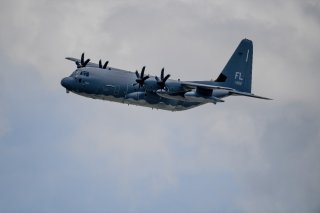C-130s Will Work Both as Cargo Planes AND Drone Carriers
DARPA is exploring the idea.
Here's What You Need To Remember: The idea of the Gremlins program is to demonstrate a manned aircraft can dispatch drones toward a target and then recover them, all while staying out of range of enemy air defenses. “Once Gremlins complete their mission, the transport aircraft would retrieve them in the air and carry them home, where ground crews would prepare them for their next use within 24 hours,” said DARPA.
Current drones, like the Reaper and Global Hawk, are true unmanned aircraft: they must operate from an airfield, just like manned aircraft have done for more than a century.
But what if the airfield was actually an airplane?
DARPA, the Pentagon’s pet research agency, has successfully conducted tested launching and recovering a drone by a manned aircraft in mid-air. A C-130 transport became a mothership to an X-61A Gremlin drone.
“The test in late November at the U.S. Army’s Dugway Proving Ground in Utah included one captive-carry mission aboard a C-130A and an airborne launch and free flight lasting just over an hour-and-a-half,” according to a DARPA announcement.
The idea of the Gremlins program is to demonstrate a manned aircraft can dispatch drones toward a target and then recover them, all while staying out of range of enemy air defenses. “Once Gremlins complete their mission, the transport aircraft would retrieve them in the air and carry them home, where ground crews would prepare them for their next use within 24 hours,” said DARPA.
DARPA provided few details about the November test, other than saying that it met all objectives, including gathering launch and recovery, gathering flight data and testing air- and ground-based command systems. “The vehicle performed well, giving us confidence we are on the right path and can expect success in our follow-on efforts,” said Gremlins program manager Scott Wierzbanowski. “We got a closer look at vehicle performance for launch, rate capture, engine start, and transition to free flight. We had simulated the performance on the ground, and have now fully tested them in the air. We also demonstrated a variety of vehicle maneuvers that helped validate our aerodynamic data.”
Kratos, one of the subcontractors on the development team, said the one hour and 41 minute test flight included “deploying the GAV [Gremlins Air Vehicle] docking arm.” The test also included a parachute recovery of a Gremlin as part of the test: the drone would normally be recovered in flight.
Ironically, the dictionary defines “gremlin” as “an imaginary mischievous sprite regarded as responsible for an unexplained problem or fault, especially a mechanical or electronic one.” Indeed, a fault did occur during the test, DARPA admitted.
“A parachute anomaly occurred in a recovery sequence that is specific to the test series and not part of the operational plan. The incident resulted in the loss of the test vehicle, one of five in the program. Four vehicles remain operational and available for the test series, which will continue in 2020.”
While the C-130 is the current demonstration aircraft for the Gremlin program, the system could be modified “for another transport aircraft or other major weapons system,” DARPA said. “Gremlins also can incorporate several types of sensors up to 150 pounds, and easily integrate technologies to address different types of stakeholders and missions.”
But equally intriguing is the potential to bring drones to the battlefield. With a range of more than 2,000 miles, a C-130 mothership could bring its squadron of drones closer to the target , rather than forcing them to fly hundreds or thousands of miles from a fixed airbase.
Michael Peck is a contributing writer for the National Interest. He can be found on Twitter, Facebook, or on his Web site. This article first appeared last year.
Image: Wikipedia.

